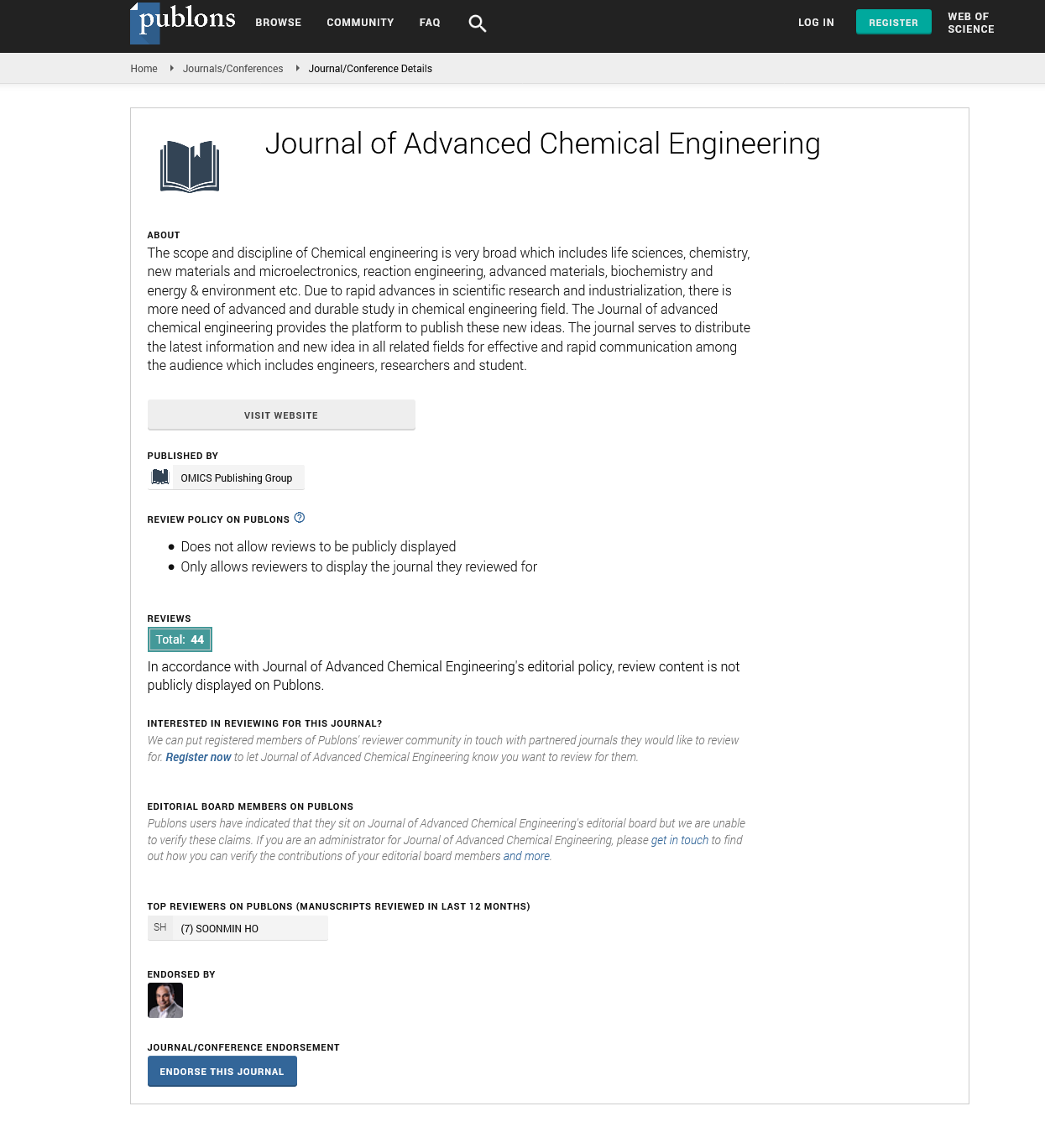Indexed In
- Open J Gate
- Genamics JournalSeek
- Smithers Rapra
- RefSeek
- Directory of Research Journal Indexing (DRJI)
- Hamdard University
- EBSCO A-Z
- OCLC- WorldCat
- Scholarsteer
- Publons
- Geneva Foundation for Medical Education and Research
- Google Scholar
Useful Links
Share This Page
Journal Flyer

Open Access Journals
- Agri and Aquaculture
- Biochemistry
- Bioinformatics & Systems Biology
- Business & Management
- Chemistry
- Clinical Sciences
- Engineering
- Food & Nutrition
- General Science
- Genetics & Molecular Biology
- Immunology & Microbiology
- Medical Sciences
- Neuroscience & Psychology
- Nursing & Health Care
- Pharmaceutical Sciences
Perspective - (2023) Volume 13, Issue 3
Reaction Kinetics: Understanding the Dynamics of Chemical Reactions
Jacob Molefe*Received: 02-Jun-2023, Manuscript No. ACE-23-22077; Editor assigned: 05-Jun-2023, Pre QC No. ACE-23-22077 (PQ); Reviewed: 19-Jun-2023, QC No. ACE-23-22077; Revised: 26-Jun-2023, Manuscript No. ACE-23-22077 (R); Published: 03-Jul-2023, DOI: 10.35248/2090-4568.23.13.290
Description
Reaction kinetics is a fundamental branch of chemical engineering that deals with the study of the rate at which chemical reactions occur and the factors that influence these rates. It plays a significant role in understanding and optimizing chemical processes, designing reactors, and predicting reaction outcomes. By investigating the underlying mechanisms and kinetics of reactions, engineers can enhance reaction efficiency, control reaction pathways, and improve product yields.
Principles of reaction kinetics
Reaction kinetics is founded on the principles of chemical kinetics, which aim to describe and quantify the rate of chemical reactions. The rate of a reaction is defined as the change in concentration of reactants or products with respect to time. The rate law expresses the relationship between the concentrations of reactants and the rate of the reaction, typically determined through experimental observations. The rate law is often represented as a mathematical expression involving rate constants and reactant concentrations raised to certain powers, known as the reaction order.
Several factors influence the rate of chemical reactions, and understanding them is vital for optimizing reaction conditions. Temperature plays a significant role, as most reactions exhibit an increase in rate with temperature due to the higher kinetic energy of molecules, which leads to more frequent collisions and greater chances of successful collisions. Activation energy, the energy barrier that reactant molecules must overcome for a reaction to occur, is another crucial factor.
Additionally, the concentration of reactants affects the reaction rate. In many cases, increasing reactant concentration enhances the reaction rate by increasing the frequency of collisions. However, there may be instances where the rate becomes independent of reactant concentration or decreases at higher concentrations due to factors such as the formation of reaction intermediates or the involvement of multiple reaction steps.
The presence of catalysts can significantly alter reaction rates by providing an alternative reaction pathway with lower activation energy. Catalysts increase reaction rates without being consumed in the process, allowing them to participate in multiple reaction cycles.
Experimental techniques in reaction kinetics
Chemical engineers employ various experimental techniques to investigate and measure reaction rates. One commonly used method is the continuous monitoring of reactant or product concentrations over time. Spectroscopic techniques, such as UV- Vis spectroscopy, infrared spectroscopy, and Nuclear Magnetic Resonance (NMR), enable real-time analysis of reactant/product concentrations and offer insights into reaction kinetics.
Another approach involves measuring the production of heat or consumption of heat during a reaction. Calorimetry techniques, such as Differential Scanning Calorimetry (DSC) and isothermal calorimetry, provide valuable information about reaction rates and enthalpy changes. These techniques are particularly useful for exothermic or endothermic reactions.
Isotopic labeling is employed to study reaction mechanisms and pathways. By introducing isotopically labeled atoms into reactant molecules, engineers can track the fate of these atoms during the reaction, elucidating reaction mechanisms and identifying intermediate species.
Mathematical modeling and computational simulations are vital tools in reaction kinetics.
These techniques utilize mathematical equations and computer algorithms to predict reaction rates and simulate complex reaction networks. They provide a deeper understanding of reaction mechanisms and aid in reactor design and optimization.
Citation: Molefe J (2023) Reaction Kinetics: Understanding the Dynamics of Chemical Reactions. Adv Chem Eng. 13:290.
Copyright: © 2023 Molefe J. This is an open-access article distributed under the terms of the Creative Commons Attribution License, which permits unrestricted use, distribution, and reproduction in any medium, provided the original author and source are credited.

